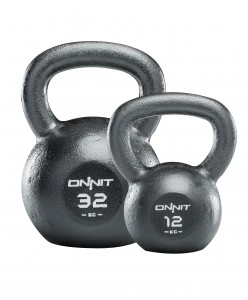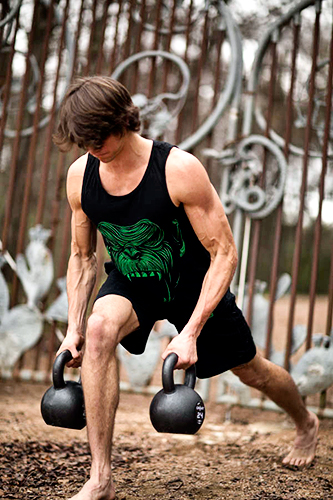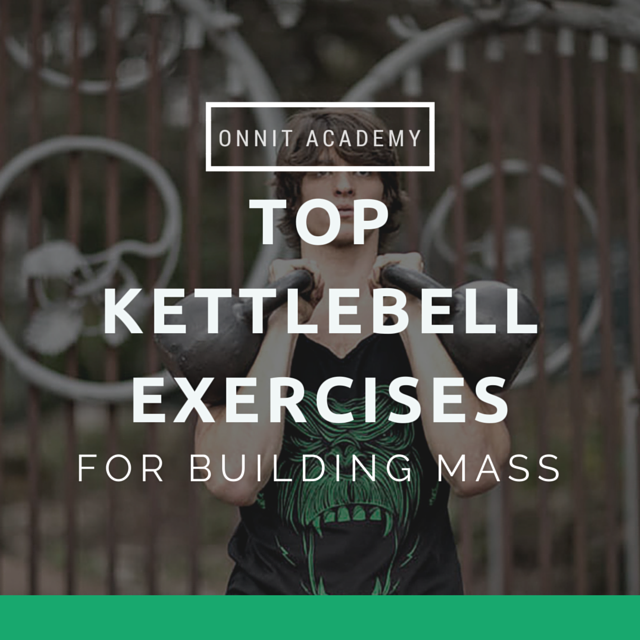I can hear the cries from gyms all over the world:
“KETTLEBELLS ARE JUST FOR CARDIO!”
“KETTLEBELLS ARE JUST FOR SWINGING!”
“KETTLEBELLS ARE JUST A FAD!”
Due to a few trainers in the world, kettlebells have been exclusively associated with cardio and should be no heavier than 15 pounds. Well, no wonder people think they can’t build muscle with them!
Kettlebells are fantastic for building strength and muscle just like the all-powerful barbell. When it comes to building muscle there are three incredibly important aspects that must be present:

Due to a few trainers in the world, kettlebells have been exclusively associated with cardio, but the reality is kettlebells are fantastic for building strength and muscle just like the all-powerful barbell.
A. Progressive Overload Regardless of the Stimulus
It doesn’t matter if it’s your bodyweight, a barbell, dumbbells, or kettlebells as long as there is a progression of lifting heavy weights often; your body will adapt by getting stronger. Beyond heavier weights, time under tension becomes a critical factor.
You’re not going to grow unless you increase the time in which your muscles are being stimulated (and I’m not talking about a massage). Muscular growth is triggered by this, but won’t happen unless the next two pieces of the puzzle are in place.
B. Proper Nutrition
Are you eating? Literally, right now, what’s in your hand? If you want to build muscle you need to be like Brad Pitt in nearly every scene of Ocean’s 11. Eat, eat, and eat some more. Quality is just as important as quantity. Sure you can build muscle with thousands of calories of burgers and fries, but quality should always come first.
The “right now” dictates that it’s not vitally important where the calories come from in terms of protein, fat, and carbs, but the long-term scope of your health should be your main driving force. Focus on quality and then quantity.
C. Plenty of Rest
Rest is free, relatively easy to get, and is infinitely helpful at building your body. Your body goes hard to work at repairing and adapting to everything you did during your session to make sure you come back stronger tomorrow to handle whatever life throws at you.
As long as these three things are present, let the muscle-building begin! Here are my top 6 Kettlebell Movements for building muscle:
#1. Kettlebell Double Clean & Press
This is a powerful movement (technically a few movements) that recruit a ton of muscle. When it comes to kettlebell exercises, few movements build muscle like the Double Clean & Press. With a combination of a hinge, pull, and press movement, you hit multiple, large muscle groups that will illicit growth (provided it’s the right amount of stimulus).
The Double Clean & Press can be manipulated in a number of ways during your training session to build your body such as, supersets combined with pull ups, ladders, timed sets, and more.
#2. Kettlebell Double Front Squat
They say that the squat is the king of movements, right? I’m not as infatuated as most, but I do understand the importance of the squat for not only building a strong, sexy pair of gams, but also for building your entire core and even your upper body.
Take the Double Kettlebell Front Squat for example; not only are you fighting the movement with your legs to get yourself back to standing after a nice deep squat, you’re also fighting the weights as they try to go in two separate directions. This puts your shoulders, arms, and upper back into the equation. Muy bueno for building muscle!
#3. Kettlebell Seesaw Floor Press
The problem with kettlebells is that most movements don’t hit the horizontal push pattern; enter the Floor Press! My favorite variation as it keeps the time under tension a bit greater is the Seesaw Press. Lie back flat and bring up both weights into a locked out position. Lower one (without slamming your elbow into the ground) and let the fun begin.
As you press that kettlebell, lower the other one. Reverse the motion in a controlled manner so the kettlebells always meet in the middle. This is tougher than it looks, but will do a number on your chest, shoulders, and triceps. Bonus tip: I like to elevate my hips to hit different parts of my chest and shoulders and incorporate the lower body into the exercise as well. Give it a try and thank me later.
 #4. Kettlebell Seesaw Row
#4. Kettlebell Seesaw Row
Similar to the Seesaw Floor Press in that the kettlebells meet in the middle during a fluid motion, the Seesaw Row keeps the tension on the back (from lower to upper and everything in between), shoulders, biceps, and core.
Multiple muscle groups for the win! The added benefit of this movement is that you’re in a constant (slight) hinge to stay in a position which taxes the glutes and quads. Your grip also gets a nice beating as well.
#5. Kettlebell Double Snatch
This is power and body awareness all rolled into one. Double snatches build big, strong shoulders and backs. Look at Olympic lifters and tell me that lifting heavy things overhead doesn’t build the upper body.
This really is a full body movement that will tax you to your core. Kettlebells make the movement a bit less technical than with the barbell, making it an easier solution for the average trainee to jump in on the fun.
#6. Kettlebell Bent Press
While all the other movements require a couple of equal kettlebells, the Bent Press is one of those movements that hits plenty with only one. By adding the twisting, squatting component to the movement, you recruit your entire body (less the arm without a kettlebell) and a ton of mobility.
You don’t need to go heavy with this one, but when you do (when you’re ready) you’ll see some amazing growth and the ability to lift heavier in other movements. When I went on a Bent Press rampage with moderate weight for low reps and high sets I saw my shoulders and triceps improve greatly while my overall mobility went through the roof. I wasn’t pushing hundreds of a pounds, but only 53-80 pounds (24-40kg) was plenty depending on the day.
There you have it. Six of my favorite muscle-building, strength-inducing, body-building kettlebell movements that will turn you from a kettlebell nerd swinging the 15 pounder to a strong, lean muscular athlete in no time.
Kettlebell Mass Building Workout
Here is a sample workout that will get you started with the six movements.
Perform all rounds of group A before moving onto Group B. Rest 60 seconds in between sets in all groups. No rest between arms in group B.
A1: Double Kettlebell Snatch – 6 rounds x 3 reps*
B1: Double Kettlebell Clean & Press and Front Squat Ladder – 3 rounds x 1-6 ladders**
C1: Bent Press Practice – 5 rounds x 3 reps (each arm)
D1: Kettlebell Seesaw Row – 3 rounds x 8-15 reps
D2: Kettlebell Seesaw Floor Press – 3 rounds x 8-15 reps
D2: Kettlebell Seesaw Floor Press – 3 rounds x 8-15 reps
Notes

*Focus on the movement. Make it powerful and smooth.

*Focus on the movement. Make it powerful and smooth.
**Perform 1 rep of each and then take a few second break. Perform 2 reps of each and then break. Repeat until 6 rounds are complete. Time how long that took you. Attempt to lessen the time with the same weight. Once you lessen it by 45-60 seconds, go to the next weight up. You may need to use different weights for the Clean & Press and Front Squat.






 Поворот с гирей лёжа рекомендуется как для профилактики травм плеча, так и для реабилитационного периода после травм. Упражнение начните выполнять с относительно лёгкого для вас веса. Поставить его можно или в разминку-начало тренировки или в конец. Рекомендуемое количество повторений: 3-5.
Поворот с гирей лёжа рекомендуется как для профилактики травм плеча, так и для реабилитационного периода после травм. Упражнение начните выполнять с относительно лёгкого для вас веса. Поставить его можно или в разминку-начало тренировки или в конец. Рекомендуемое количество повторений: 3-5.









